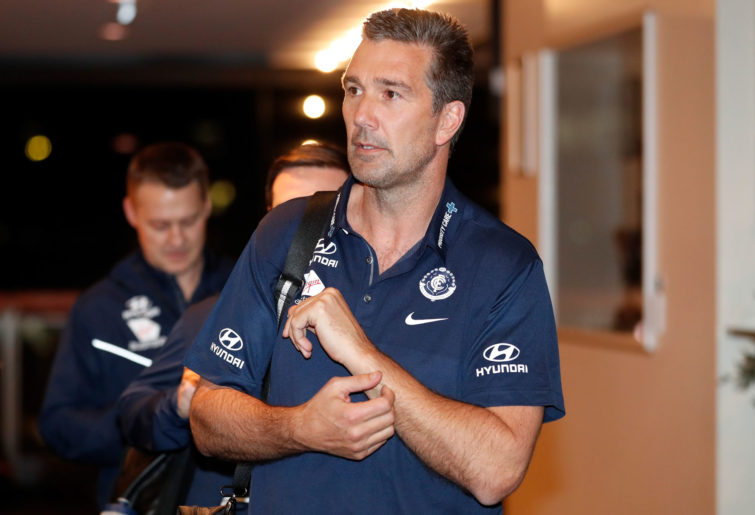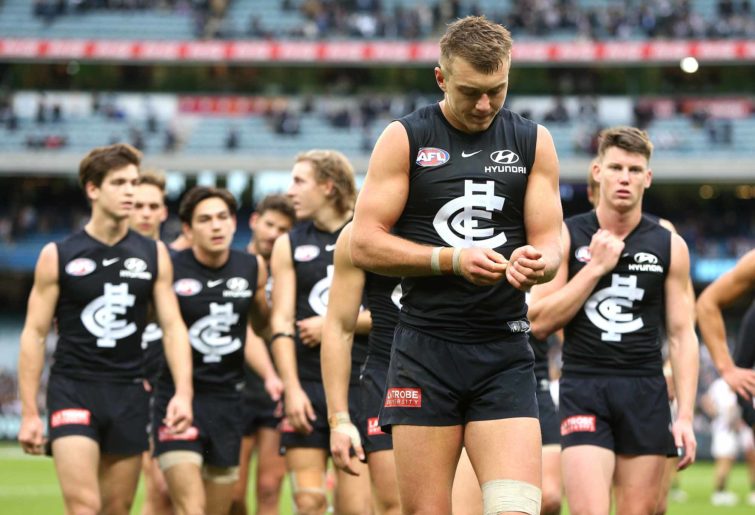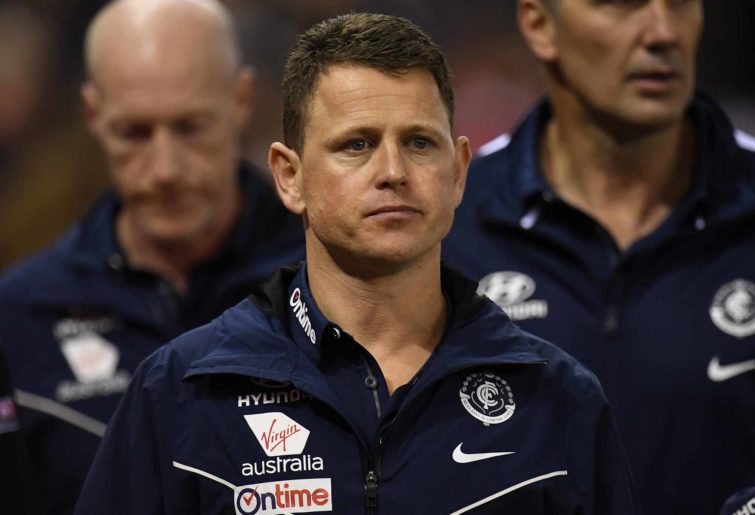The axe blade never grows dull at Carlton.
Earlier this month, after five years as the Blues’ list management boss, Stephen Silvagni – a famous name at the club and in the AFL through his playing career alone – was loudly shown the door.
When Silvagni arrived at the club at the beginning of the 2015 season, he inherited a list that would that year go on to win the club’s fourth wooden spoon since the turn of the millennium.
A shallow analysis would point out that, five years on, Silvagni’s management has only seen the club improve to 16th in 2019.
But that belies the remarkable transformation of the list that has occurred under his reign.
Of the players who appeared for Carlton in that 2015 season, only eight represented the club again at least once in 2019.
That is the fewest of any club in the AFL – even Gold Coast had at least nine players in common between the two seasons, while Adelaide shared 18.
Carlton, in five drafts under Silvagni, have brought 11 first-round draft picks through the door, behind only the AFL’s two expansion clubs.
Certainly, this transformation has not yet borne so much fruit as fans of the club would hope to realise, but it’s clear the Blues possess a mass of highly rated junior talent ready to flower.

(Photo by Michael Willson/AFL Media/Getty Images)
A list manager alone cannot steer the fortunes of a club, however, and after 12 months in the role, Silvagni was joined at Carlton by a new prominent face: Brendon Bolton.
Coaching a list Silvagni had only begun to transform in 2016, Bolton fielded the AFL’s sixth-oldest average 22, achieving a better-than-expected seven wins and finishing outside the bottom four.
In 2017 however, he made a significant pivot towards youth, fielding the third-youngest side in the competition in that year and the fifth-youngest in 2018.
In the four years since Bolton arrived at the club, Carlton have pumped 359 games into those 11 first-rounders drafted by Silvagni.
No other side in the league has invested so many games into players picked in the first round over the last five drafts. Thirteen clubs have put in less than half that.
Bolton’s biggest move came in 2018, when although the average age of his side remained simillar to the previous season, he moved his younger players into more prominent positions.
Centre clearance numbers offer a good illustration of this: In 2017, Carlton’s 22-and-under brigade won 34 per cent of the side’s centre clearances. In 2018, the same age bracket won 60 per cent.
Bolton, after drilling the Blues to play defence in his first two seasons, also signalled an intention to play a more attacking brand of footy. The approach worked well in the pre-season, but not when the rubber met the road.
Overall, Bolton’s 2018 was a boon for younger players. As a group, the 22-and-unders recorded 150+ more score involvements than they had the previous year.
This put the club in the top six that year for score involvements by players aged 22 or younger, after being in the bottom six for that stat the previous season.
However, the improvement from Carlton’s youth was not nearly good enough to offset the corresponding decline in performance from older players, and the Blues’ on-field fortunes suffered markedly.
They won only two games and finished last on the ladder, conceding nearly two goals more per game than they had the previous year and – despite the intention to be more aggressive – suffering an even larger decrease in scoring.

(AAP Image/Hamish Blair)
Entering 2019 under more significant scrutiny than ever before, Bolton faced a choice between hedging his bets to preserve his own future or doubling down on his 2018 strategy.
He chose the latter, and it proved to be the end of him.
Because Bolton and his eventual successor David Teague both coached the Blues through 11 games this year, they offer a perfectly balanced split from which to draw comparisons.
Bolton’s 2019 Blues were the youngest side he’d yet coached in the AFL and third-youngest in the league on average.
Fifty-one per cent of his centre clearances were won by players 22 and under, the largest proprotion of any side in the league.
The Blues took five weeks to find their first win of the season, a breakthrough 44-point victory over the Western Bulldogs, and then had a mid-table-but-still-respected Hawthorn on the ropes at half-time the following week.
The Hawks came back in the second half to steal victory. Young Carlton spearhead Harry McKay would’ve had a post-siren shot for the win had the ball found his hands just a second earlier, but it was not to be.
That loss seemed to suck all momentum out of Bolton’s side and they dropped their next five matches in a row, a stretch which included losing winnable games against North Melbourne and St Kilda.
After an insipid 43-point loss to Essendon where they kicked only four goals, Carlton powerbrokers decided they’d had enough and gave Bolton the boot.
David Teague was named interim coach and immediately made big changes, selecting a side that was not just older on paper but had more experienced players back into the most important roles on the ground.
Under Teague, Carlton dropped from the third to only the seventh-youngest side in the competition. Their age increase from the first half of the year to the second was the fourth-largest in the league.
By comparison, North Melbourne, who changed coaches at a similar point in time, were one of just four teams in the league to field a younger side on average after Round 11 than they had before it.
Under Bolton, half the Blues’ centre clearances had been won by younger players. Under Teague, 54 per cent were won by players 28 or older, changing them from the side most skewed to youth in this stat to the one most skewed towards veterans.
Simillar if less pronounced trends also occurred in other significant stats like metres gained and inside 50s, but to Teague’s credit, Carlton’s young players didn’t record any fewer score involvements under him than they did Bolton.
Bolton’s greatest mistake was that he simply bet too soon on Carlton’s kids.
He did what the thought was best for the team, and the experience and responsibility he gave to his young charges may someday vindicate him. But the immediate negative impacts were simply more than the club could bear.

(AAP Image/Julian Smith)
The reason for Silvagni’s sacking, on the other hand, is much less clear cut.
Carlton’s party line is that, with two of his sons on the list, it was untenable for SOS to continue his position at the club, being “unable to participate in an increasing number of discussions and decisions relating to both list management and match committee”.
However, a wide variety of sources outside the club including the AFL website itself have noted a reported rift between Silvagni and new club CEO Cain Liddle that many believe to be the true reason for his departure.
I know no more than anyone else here, but it’s fair to say that Carlton’s explanation doesn’t pass the sniff test.
Jack Silvagni has been on the Blues list for four years and it hasn’t been a problem till now. Jack’s own social media activity in the time since has suggested Carlton’s version of the story leaves a lot to be told.
No one expects an AFL club to admit the list boss has been sacked because he’s feuding with the CEO. But to proffer a flimsy alternate explanation that drags his own sons into the mess is, frankly, appalling treatment of someone who has contributed so much to the club on and off the field.
Instead, Silvagni – and I would suggest Bolton also – will stand as an example of a phenomenon all too common in the AFL, that those who plant the tree are so often chewed up and spat out before getting their chance to taste the fruit.
In June after the Bolton sacking I wrote that Silvagni’s list strategy had been one that deliberately drew out the length of Carlton’s list build, but would eventually see them head in the right direction.
Most readers read that article as critical. It was intended to be as such, but to also be a positive assessment, which did not shine through as much as I’d have liked it to. As I wrote, “while not every move has proved a winner, he (Silvagni) has still turned Carlton’s list into one that has plenty of budding talent.”
Much depends now on the guiding hands of David Teague – and whoever the Blues recruit as SOS’ replacement – but given the talent Carlton have assembled and the AFL experience they’ve pumped into them, it’s hard not see the Blues going on to enjoy at least some moderate form of success.
Sadly, some who have contributed their fair share to it will need to watch from afar, still nursing the wounds around their necks.

(Photo by Scott Barbour/Getty Images)
A quick note for those who may be surprised to see a column from me today – as you may have heard, my time as part of The Roar’s editorial staff has come to an end.
However, in good (or bad) news, I will still be contributing regular columns to the site as part of the expert team, hopefully for a long time to come.
































































































